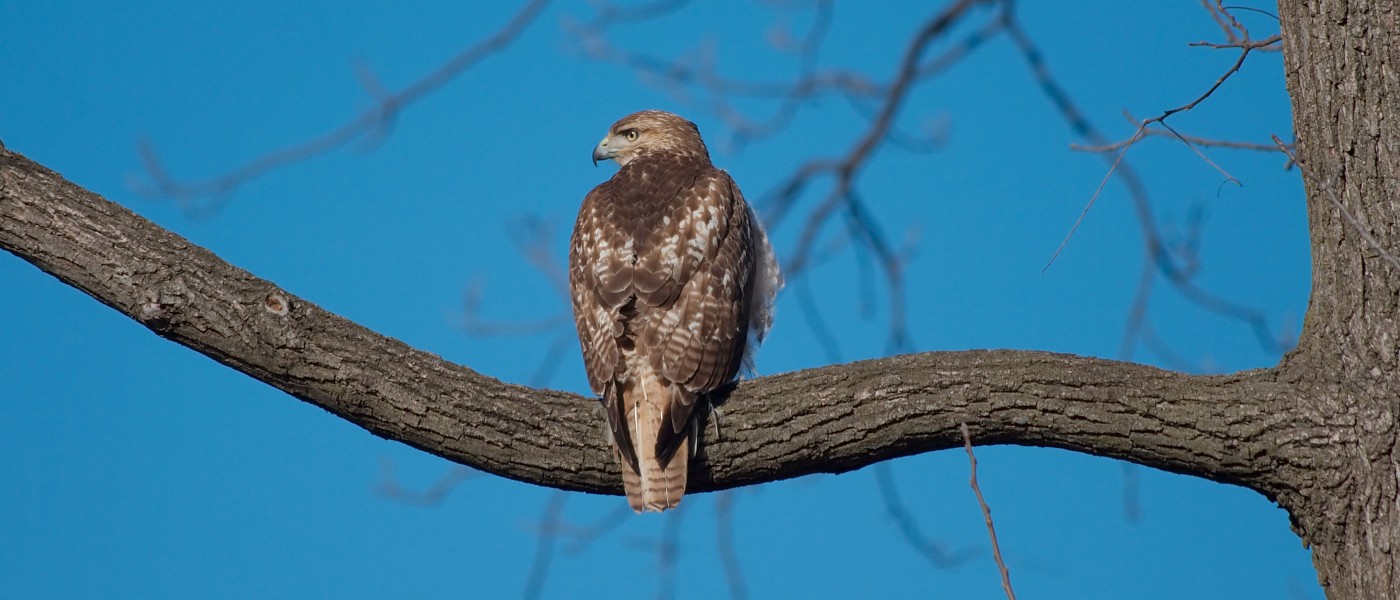Birds of Brooklyn: Red-Tailed Hawk
The red-tailed hawk (Buteo jamaicensis) is a very common raptor in the New York City area, so much so that the rule goes, when you see a hawk, “It’s a red-tailed hawk unless proven otherwise.” This species is a breeder in Prospect Park as well as other city parks in the NYC area, and there’s a pair that regularly nests in the Japanese Hill-and-Pond Garden at BBG. Red-tailed hawks, including the famous Pale Male, also nest on buildings surrounding Central Park.
This hawk species is widespread across most of North America, and here it is both a year-round resident and a seasonal migrant. It’s also not too hard to identify. It is large and quite noisy, mostly brown but with a lot of variation in its coloring. Adult birds have a well-defined red tail, hence its common name, but immature birds can have a mostly brown tail.
For identification purposes, good field marks to look for are its white throat, dark belly band, and white lower belly. From the back, the bird appears to have suspenders, a good field mark when you can’t see the front of the bird. Males and females look alike. Its most well-known call is a long, high-pitched, rasping kreeeer, usually made while soaring through the sky.
Around this time of year, late March, the birds pair off and begin the nesting process. A lot of times they nest with the same partner as the year before, just sprucing up their old nest a bit for the new season. Red-tails perform a very nice courtship display, sometimes locking talons while in flight and spinning around in the sky before releasing their grasp.
The most famous bird in New York City—and probably the world—is the NYC-based red-tailed hawk Pale Male. In the early 1990s, this bird was discovered nesting on a building ledge on Fifth Avenue, across from Central Park—the first recorded incidence of a red-tail living on a building instead of a tree.
Pale Male has since mated with eight different female hawks and sired many, many eyases. Remarkably, he has stayed in place, mating and fathering broods, for over 25 years. Some of the offspring have also been spotted nesting on buildings surrounding Central Park. Pale Male has inspired a book (Red-Tails in Love) and a documentary and has become a major tourist attraction in NYC. I’ve spoken to people from Europe about birds in New York, and the only thing they know is that this is where Pale Male lives.
As we get ready for spring migration and the nesting period for birds in the NYC area, scan the skies and listen for sounds. Very likely you will find a red-tailed hawk. There’s a good chance you’ll see BBG’s resident pair soon. For the past several springs, they’ve been spotted tending their nest in the Japanese Hill-and-Pond Garden. They are frequently seen mating and hunting for rabbits, squirrels, and smaller birds. They nest once a year and usually hatch a brood of two or three eyases. Visitors often spot the young birds learning to fly and hunt later in the summer.
The Birds of Brooklyn series looks at some of the most familiar and fascinating birds that call Kings County their habitat.


